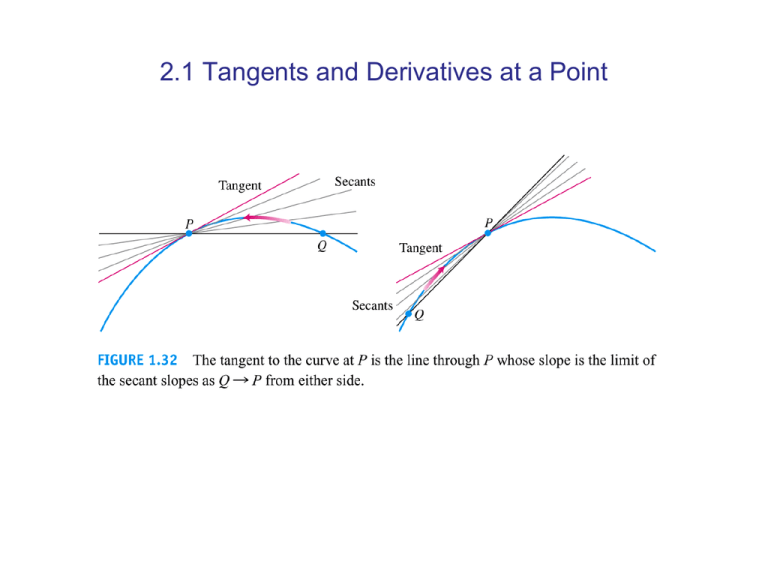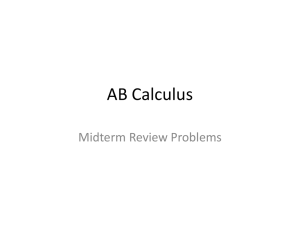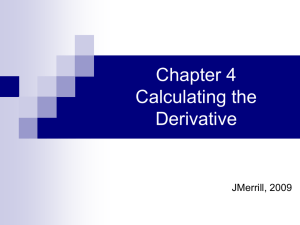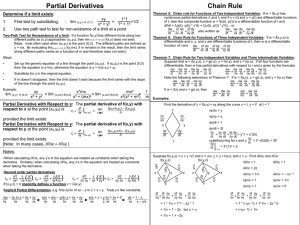The Tangent Line Problem and The Area Problem (p. 101)
advertisement

2.1 Tangents and Derivatives at a Point Finding a Tangent to the Graph of a Function To find a tangent to an arbitrary curve y=f(x) at a point P(x0,f(x0)), we • Calculate the slope of the secant through P and a nearby point Q(x0+h, f(x0+h)). • Then investigate the limit of the slope as h0. Slope of the Curve If the previous limit exists, we have the following definitions. Reminder: the equation of the tangent line to the curve at P is Y=f(x0)+m(x-x0) (point-slope equation) Example (a) Find the slope of the curve y=x2 at the point (2, 4)? (b) Then find an equation for the line tangent to the curve there. Solution Rates of Change: Derivative at a Point The expression f ( x h) f ( x ) h is called the difference quotient of f at x0 with increment h. If the difference quotient has a limit as h approaches zero, that limit is named below. Summary 2.2 The Derivative as a Function We now investigate the derivative as a function derived from f by Considering the limit at each point x in the domain of f. If f’ exists at a particular x, we say that f is differentiable (has a derivative) at x. If f’ exists at every point in the domain of f, we call f is differentiable. Alternative Formula for the Derivative An equivalent definition of the derivative is as follows. (let z = x+h) Calculating Derivatives from the Definition The process of calculating a derivative is called differentiation. It can be denoted by d f '( x) or f ( x) dx 2 Example. Differentiate f ( x) x Example. Differentiate f ( x) x for x>0. Notations There are many ways to denote the derivative of a function y = f(x). Some common alternative notations for the derivative are f '( x) y ' dy df d f ( x) D( f )( x) Dx [ f ( x)] dx dx dx To indicate the value of a derivative at a specified number x=a, we use the notation f '(a) dy df d |x a |x a f ( x) | x a dx dx dx Graphing the Derivative Given a graph y=f(x), we can plot the derivative of y=f(x) by estimating the slopes on the graph of f. That is, we plot the points (x, f’(x)) in the xy-plane and connect them with a smooth curve, which represents y=f’(x). Example: Graph the derivative of the function y=f(x) in the figure below. What we can learn from the graph of y=f’(x)? Differentiable on an Interval; One-Sided Derivatives If a function f is differentiable on an open interval (finite or infinite) if it has a derivative at each point of the interval. It is differentiable on a closed interval [a, b] if it is differentiable on the interior (a, b) and if the limits lim f ( a h) f ( a ) h Right-hand derivative at a lim f (b h) f (b) h Left-hand derivative at b h 0 h 0 exist at the endpoints. A function has a derivative at a point if and only if the left-hand and right-hand derivatives there, and these one-sided derivatives are equal. When Does A Function Not Have a Derivative at a Point A function can fail to have a derivative at a point for several reasons, such as at points where the graph has 1. a corner, where the one-sided derivatives differ. 2. a cusp, where the slope of PQ approaches from one side and - from the other. 3. a vertical tangent, where the slope of PQ approaches from both sides or approaches - from both sides. 4. a discontinuity. Differentiable Functions Are Continuous Note: The converse of Theorem 1 is false. A function need not have a derivative at a point where it is continuous. For example, y=|x| is continuous at everywhere but is not differentiable at x=0. 2.3 Differentiation Rules The Power Rule is actually valid for all real numbers n. Examples Example. Constant Multiple Rule d d [ x11 ] [ x11 ] (11x10 ) 11x10 dx dx d d 2 [ 2 ] [ x ] (2 x 3 ) 2 x 3 dx x dx Note: d d d du (u ) (1 u ) 1 (u ) dx dx dx dx Example. Derivative Sum Rule Example. Derivative Product Rule In function notation: d [ f ( x) g ( x)] f ( x) g '( x) g ( x) f '( x) dx Example Example: Find Solution: dy if y (2 x3 2)(6 x 2 3x). dx Derivative Quotient Rule In function notation: d f ( x) g ( x) f '( x) f ( x) g '( x) [ ] dx g ( x) g 2 ( x) Example Example: Solution: 2 x3 x 2 4 Find y '( x) if y . x 5 Second- and Higher-Order Derivatives The derivative f’ of a function f is itself a function and hence may have a derivative of its own. If f’ is differentiable, then its derivative is denoted by f’’. So f’’=(f’)’ and is called the second derivative of f. d 2 y d dy dy ' f ''( x) 2 ( ) y '' D 2 ( f )( x) Dx 2 [ f ( x)] dx dx dx dx Similarly, we have third, fourth, fifth, and even higher derivatives of f. A general nth order derivative can be denoted by y (n) d ( n 1) d n y y n Dn y dx dx 3 2 Example: If y 4x x 2x 6, then 2.4 The Derivative as a Rate of Change Thus, instantaneous rates are limits of average rates. When we say rate of change, we mean instantaneous rate of change. Motion Along a Line: Displacement, Velocity, Speed, Acceleration, and Jerk Suppose that an object is moving along a s-axis so that we know its position s on that line as a function of time t: s=f(t). The displacement of the object over the time interval from t to t+∆t is ∆s = f(t+ ∆t)-f(t); The average velocity of the object over that time interval is s f (t t ) f (t ) vav t t Velocity To find the body’s velocity at the exact instant t, we take the limit of the Average velocity over the interval from t to t+ ∆t as ∆t shrinks to zero. The limit is the derivative of f with respect to t. Besides telling how fast an object is moving, its velocity tells the direction of Motion. The speedometer always shows speed, which is the absolute value of velocity. Speed measures the rate of progress regardless of direction The figure blow shows the velocity v=f’(t) of a particle moving on a coordinate line., what can you say about the movement ? Acceleration The rate at which a body’s velocity changes is the body’s acceleration. The acceleration measures how quickly the body picks up or loses speed. A sudden change in acceleration is called a jerk. Example Near the surface of the earth all bodies fall with the same constant acceleration. In fact, we have s=(1/2)gt2 , where s is the distance fallen and g is the acceleration due to Earth’s gravity. With t in seconds, the value of g at sea lever is 32 ft/ sec2 or 9.8m/sec2. Example Example: Figure left shows the free fall of a heavy ball bearing released from rest at time t=0. (a) How many meters does the ball fall in the first 2 sec? (b) What is its velocity, speed, and acceleration when t=2? 2.5 Derivatives of Trigonometric Functions Example Example: Find Solution: dy if y x cos x. dx Example Example: Solution: Find dy cos x if y . dx 1 sin x Example: A body hanging from a spring is stretched down 5 units beyond Its rest position and released at time t=0 to bob up and down. Its position at any later time is s=5cos t. What are its velocity and acceleration at time t? Since tan x sin x cos x 1 1 , cot x , sec x , csc x cos x sin x cos x sin x We have Example Example: Solution: Find y '' if f ( x) tan x. 2.6 Exponential Functions In general, if a1 is a positive constant, the function f(x)=ax is the exponential function with base a. If x=n is a positive integer, then an=a a … a. If x=0, then a0=1, 1 1 n n a ( ) If x=-n for some positive integer n, then an a 1/n n If x=1/n for some positive integer n, then a a p/q p p If x=p/q is any rational number, then a a ( a ) q If x is an irrational number, then q Rules for Exponents The Natural Exponential Function ex The most important exponential function used for modeling natural, physical, and economic phenomena is the natural exponential function, whose base is a special number e. The number e is irrational, and its value is 2.718281828 to nine decimal places. The graph of y=ex has slope 1 when it crosses the y-axis. Derivative of the Natural Exponential Function Example. Find the derivative of y=e-x. Solution: Example. Find the derivative of y=e-1/x. 2.7 The Chain Rule Example Example: Let y= sin( x 2 ). Find d . dx Solution: “Outside-inside” Rule It sometimes helps to think about the Chain Rule using functional notation. If y=f(g(x)), then dy f '( g ( x)) g '( x) dx In words, differentiate the “outside” function f and evaluate it at the “inside” function g(x) left alone; then multiply by the derivative of the “inside” function. Example Example. Differentiate sin(2x+ex) with respect to x. Solution. Example. Differentiate e3x with respect to x. Solution. In general, we have For example. d sin x d (e ) esin x (sin x) esin x cos x dx dx Example: find derivative of |x| when x ≠ 0. Repeated Use of the Chain Rule Sometimes, we have to apply the chain rule more than once to calculate a derivative. Example. Find Solution. d [sin(tan 3 x)]. dx The Chain Rule with Powers of a Function If f is a differentiable function of u and if u is a differentiable function of x, then substituting y = f(u) into the Chain Rule formula leads to the formula d du f (u ) f '(u ) dx dx This result is called the generalized derivative formula for f. For example. If f(u)=un and if u is a differentiable function of x, then we can Obtain the Power Chain Rule: d n du u nu n 1 dx dx Example Example: Solution: Find d ( x 2)8 dx Example Example: Solution: Find d [ tan x ]. dx Example Example: Solution: Find d [(1 sec3 x)10 ] dx 2.8 Implicit Differentiation Definition. We will say that a given equation in x and y defines the function f implicitly if the graph of y = f(x) coincides with a portion of the graph of the equation. Example: •The equation x2 y 2 1 implicitly defines functions f1 ( x) 1 x 2 and f 2 ( x) 1 x 2 •The equation f1( x) x y 2 implicitly defines the functions x and f 2 ( x) x Two differentiable methods There are two methods to differentiate the functions defined implicitly by the equation. For example: Find dy / dx if xy 1 1 One way is to rewrite this equation as y , from which it x dy 1 2 follows that dx x Two differentiable methods The other method is to differentiate both sides of the equation before solving for y in terms of x, treating y as a differentiable function of x. The method is called implicit differentiation. With this approach we obtain d [ xy ] d [1] dx dx d d x [ y ] y [ x] 0 dx dx dy x y0 dx dy y dx x 1 dy 1 Since y , 2 x dx x Implicit Differentiation Example Example: Use implicit differentiation to find dy / dx if x2 y 2 3x Solution: Example Example: Find dy / dx if y3 3x 11 0 Solution: Lenses, tangents and Normal Lines In the law that describes how light changes direction as it enters a lens, the important angles are the angles the light makes with the line perpendicular to the surface of the lens at the point of entry. surf This line is called the normal to the surface at the point of entry. The normal is the line perpendicular to the tangent of the profile curve at the point of entry. Example Show that the point (2, 4) lies on the curve x3+y3-9xy=0. Then find the tangent and normal to the curve there. Derivatives of Higher Order Find dy2 /dx2 if 2x3-3y2=8. 2.9 Inverse Functions and Their Derivatives A function that undoes, or inverts, the effect of a function f is called the inverse of f. Examples Inverse Function Note the symbol f -1 for the inverse of f is read “f inverse”. The “-1” in f -1 is not an exponent; f -1 (x) does not mean 1/f(x). Finding Inverses The process of passing from f to f -1 can be summarized as a two-step process. 1. Solve the equation y=f(x) for x. This gives f formula x=f -1(y) where x is expressed as a function of y. 2. Interchange x and y, obtaining a formula y=f -1(x), where f -1 is expressed in the conventional format with x as the independent variable and y as the dependent variable. Examples Find the inverse of (a) y=3x-2. (b) y=x2,x≥0. Solution: Derivative Rule for Inverses Derivative Rule for Inverses Example Let f(x)= x3-2. Find the value of df-1/dx at x=6 = f(2) without finding a formula for f -1 (x). 2.10 Logarithmic Functions Natural Logarithm Function Logarithms with base e and base 10 are so important in applications that Calculators have special keys for them. logex is written as lnx log10x is written as logx The function y=lnx is called the natural logarithm function, and y=logx is Often called the common logarithm function. Properties of Logarithms Properties of ax and logax Derivative of the Natural Logarithm Function Since y=lnx is the inverse function of y=ex, we have Note: d 1 [ln x] , x 0 dx x Example: Find Solution: d [ln( x3 4)] dx Example Furthermore, since |x|=x when x>0 and |x|= -x when x<0, Example: Find d [ln | cos x |] dx Solution: Derivatives of au Since ax=exlna, we can find the following result. Note that Example: d x d d du [a ] a x ln a, [e x ] e x , [eu ] eu dx dx dx dx Derivatives of logau Since logax =lnx/lna, we can find the following result. Note that Example: d 1 du ln u dx u dx Logarithmic Differentiation The derivatives of positive functions given by formulas that involve products, quotients, and powers can often be found more quickly if we take the natural logarithm of both sides before differentiating. This process is called logarithmic differentiation. ( x 2 1)( x 3)1/2 Example. Find dy/dx if y , x 1 x 1 The Number e as a Limit 2.11 Inverse Trigonometric Functions The six basic trigonometric functions are not one-to-one (their values Repeat periodically). However, we can restrict their domains to intervals on which they are one-to-one. Six Inverse Trigonometric Functions Since the restricted functions are now one-to-one, they have inverse, which we denoted by y sin 1 x or y arcsin x y cos 1 x or y arccos x y tan 1 x or y arctan x y cot 1 x or y arc cot x y sec 1 x or y arc sec x y csc 1 x or y arc csc x These equations are read “y equals the arcsine of x” or y equals arcsin x” and so on. Caution: The -1 in the expressions for the inverse means “inverse.” It does Not mean reciprocal. The reciprocal of sinx is (sinx)-1=1/sinx=cscx. Derivative of y = sin-1x Example: Find dy/dx if Solution: y sin 1 ( x2 ) Derivative of y = tan-1x Example: Find dy/dx if y tan 1 (ex ) Solution: Derivative of y = sec-1x Example: Find dy/dx if y sec1 (4 x3 ) Solution: Derivative of the other Three There is a much easier way to find the other three inverse trigonometric Functions-arccosine, arccotantent, and arccosecant, due to the following Identities: It follows easily that the derivatives of the inverse cofunctions are the negatives of the derivatives of the corresponding inverse functions. 2.13 Linearization and Differentials In general, the tangent to y=f(x) at a point x=a, where f is differentiable, passes through the point (a, f(a)), so its point-slope equation is y=f(a)+f’(a)(x-a). Thus this tangent line is the graph of the linear function L(x)=f(a)+f’(a)(x-a).. For as long as this line remains close to the graph of f, L(x) gives a good approximation to f(x). Linearization Example Find the linearization of f(x)=cosx at x=π/2. Also an important linear approximation for roots and poewrs is (1+x)k==1+kx (x near 0; any number k).








